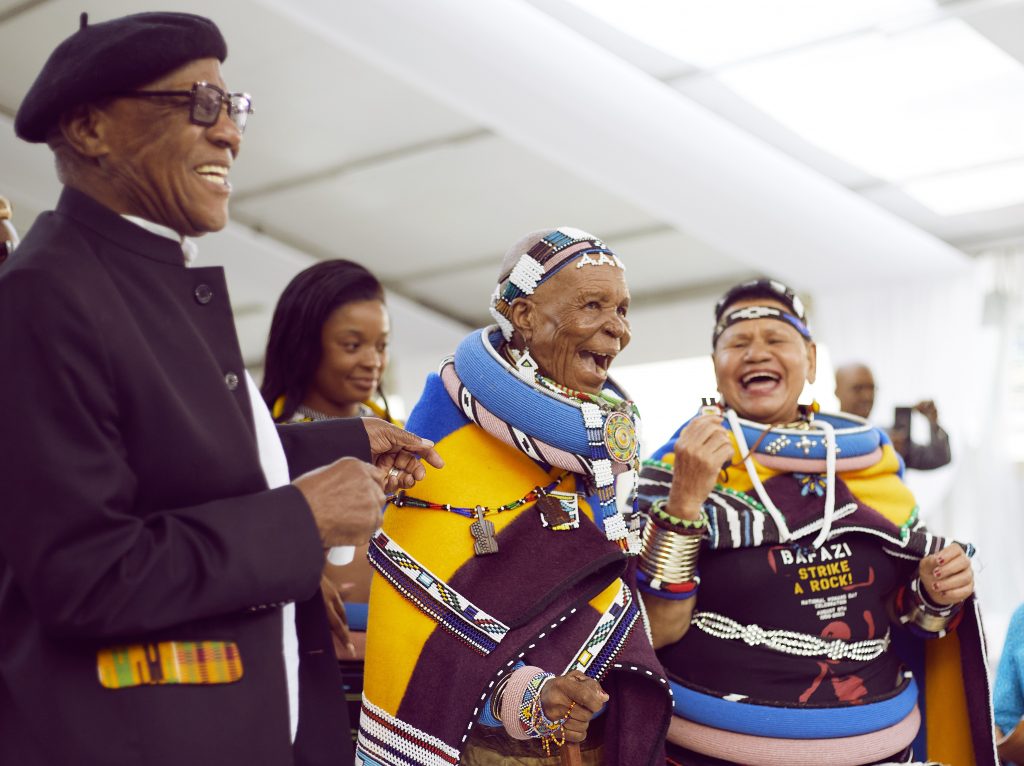

Among the glamor and festivity of Cape Town’s art week, occasional power outages cast flickers of reminder of South Africa’s lingering inequities. Within the complex societal landscape and history of the nation lies the latchkey to the Mother City’s art scene—a narrative of resilience, creativity, and evolution.
Step into the Mount Nelson Hotel, a pink-hued retreat of colonial elegance settled at the foot of Table Mountain. With a name paying homage to the 19th century British officer Admiral Nelson, it stands as an unlikely testament to the nation’s journey. The furnishings—including the Garden Room’s deck chairs which were once used on the Union-Castle Line ships—resonate with echoes of its history as a onetime headquarters for the British military (it was once home to a young war correspondent named Winston Churchill). These nostalgic architecture touches are provoked by incisive contemporary art, part of a new exhibition.
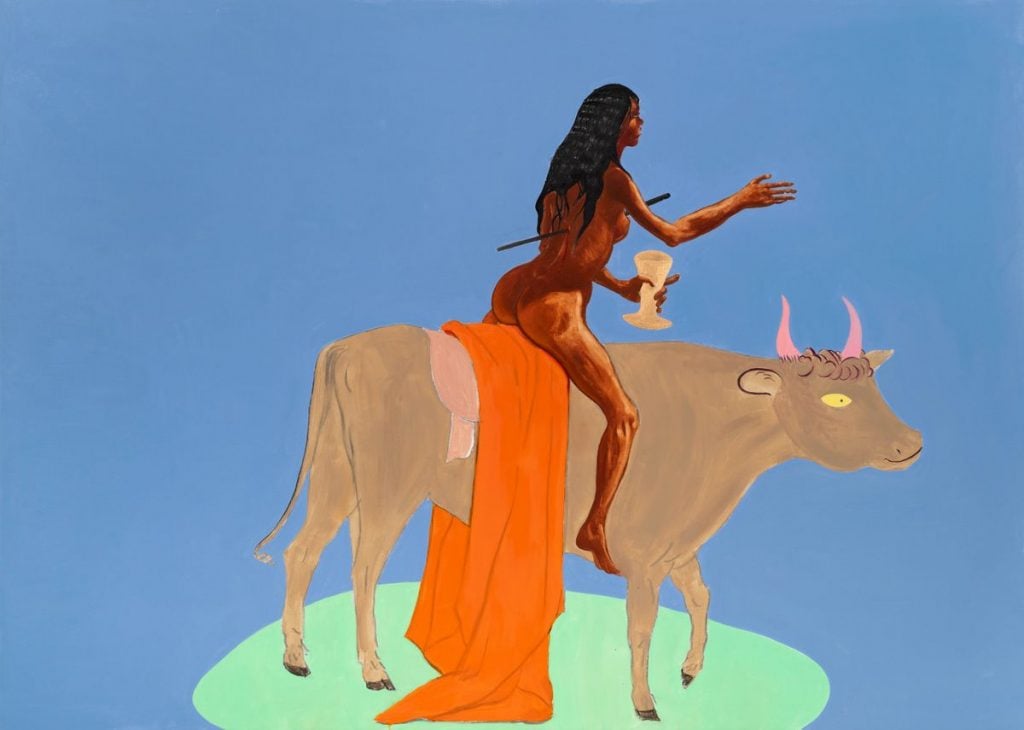
Cassi Namoda, Heartbreak takes new forms (2022). Courtesy the Homestead Collection.
Amid the clinking of teacups in the well-appointed lounge, guests are confronted by the penetrating stares from Zanele Muholi’s “MaID” self-portrait series. Elsewhere, there’s a depiction of two men kissing, a painting by Zimbabwean artist Brett Seiler. A soft, yet piercing Cassi Namoda painting—depicting a nude figure astride a cow, with a black spear penetrating her heart, steals the focus from the tinkling of the grand piano.
As the city’s annual art week unfolded, the city was alive with thought-provoking art. Here’s where to look for it.
Iziko South African National
“‘Then I Knew I Was Good at Painting’: Esther Mahlangu. A Retrospective”
Through August 11, 2024
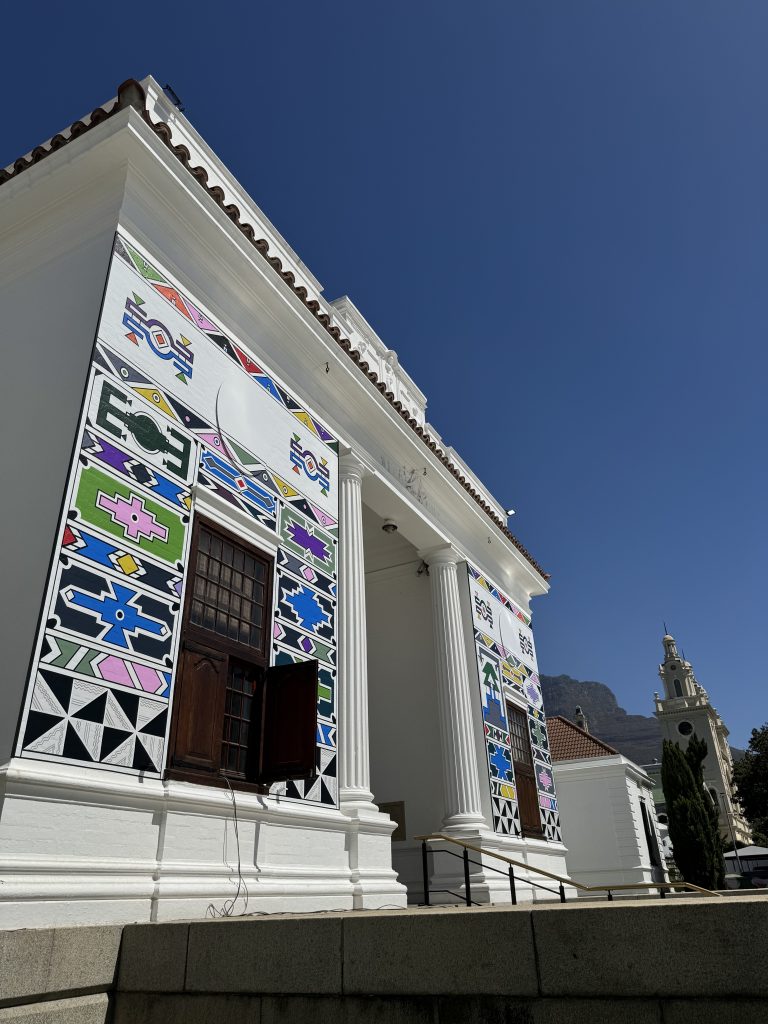
Esther Mahlangu. © BMW AG.
On Queen Victoria Street, a colorful mural of bold geometric designs interrupts the white surfaces of the national gallery’s “Cape Dutch” façade. The work is an intervention by 88-year-old painter Esther Mahlangu, who is famous among South Africans. It is, surprisingly, her first show at the institution, which historically collected Dutch, French and British works from the 17th to the 19th century, and only recently began showing contemporary work, let alone a solo exhibition of a Black female South African artist of her generation.
Mahlangu rocketed to fame after the French dealer and curator André Magnin included her work in his now polarizing 1989 “Magicians of the Earth” exhibition at the Centre Pompidou in Paris. Brand activations followed, one after another, the most remembered being her 1989 BMW art car, which had to be hoisted into the gallery for this exhibition. “That car was everywhere,” a local told me over drinks later, explaining that the commission captured the South African zeitgeist due to the affection for the colloquially termed gusheshe, a “fast” car appreciated by street culture and high society alike.
Her global success helped put South African art on the map, and the artist is today collected by celebrities from Leonardo DiCaprio to Oprah Winfrey—she has a central position in Alicia Keys and Swizz Beatz’s “Giants” show on view at the Brooklyn Museum—and will be included in Adriano Pedrosa’s 60th Venice Biennale later this year.
Mahlangu’s paintings are rooted in Ndebele art, a culture where the women decorate their homes with bright abstract symbols painted with chicken feathers. Over Mahlangu’s career, typical Ndebele motifs give way to a personal symbolism, colors evolve from washed out natural pigments to vibrant acrylic paints, and surface changes, as she transports the patterns onto everyday objects. As press gathered for the overdue showcase, curator Nontobeko Ntombela was quick to dispel any tendency towards anthropological tropes; Ndebele painting emerged in the early 1900s, making it a modernist movement, and Ntombela makes the case for Mahlangu as its singular master.
Zeitz Museum of Contemporary Art Africa
“Mame-Diarra Niang: Self as a Forgotten Monument”
Through July 7, 2024

Installation view “Mame-Diarra Niang—Self as a Forgotten Monument,” Zeitz Mocaa. Photograph by Dillon Marsh, courtesy of Zeitz MOCAA.
Located in the harbor town’s waterfront district, Zeitz MOCAA is museum inside a refurbished grain silo complex that feels a bit like a industrial space age cathedral. The museum, founded with the gift of collector Jochen Zeitz and directed by Koyo Kouoh, focuses on contemporary art from Africa and its diaspora. “What we are trying to do here is write new chapters of our art history,” Kouoh said as she was touring us through the space. “To understand how Black aesthetics have informed the world and how Black aesthetics live in the world.”
Within the dizzying circular layout of the galleries was a standout exhibition of French, Paris-based artist Mame-Diarra Niang. The retrospective show brings together a decade of her lens-based media work. Through photographs, as well as an immersive multi-channel audio-visual installation scored with a composition by the artist, the exhibition “Self as a Forgotten Monument” offers a bewitching self-portrait.
Particularly compelling was her series “Call me when you get there.” Created during lockdown, when digital excursions were all that was permitted, Niang pulled together images of different places captured by Google street view—collaging these striking images together into an imaginary panorama. In effect, the artist has created a sort of fantasy map of her own mind, including eerie glitches from the Google car’s image-capturing; distortions, blurs, figures doubled or in the midst of disappearing somehow captures the claustrophobia and tunnel vision she experienced at that time.
Church Projects
“Alka Dass: The Million Petaled Flower Of When You Were Here”
Through March 22, 2024
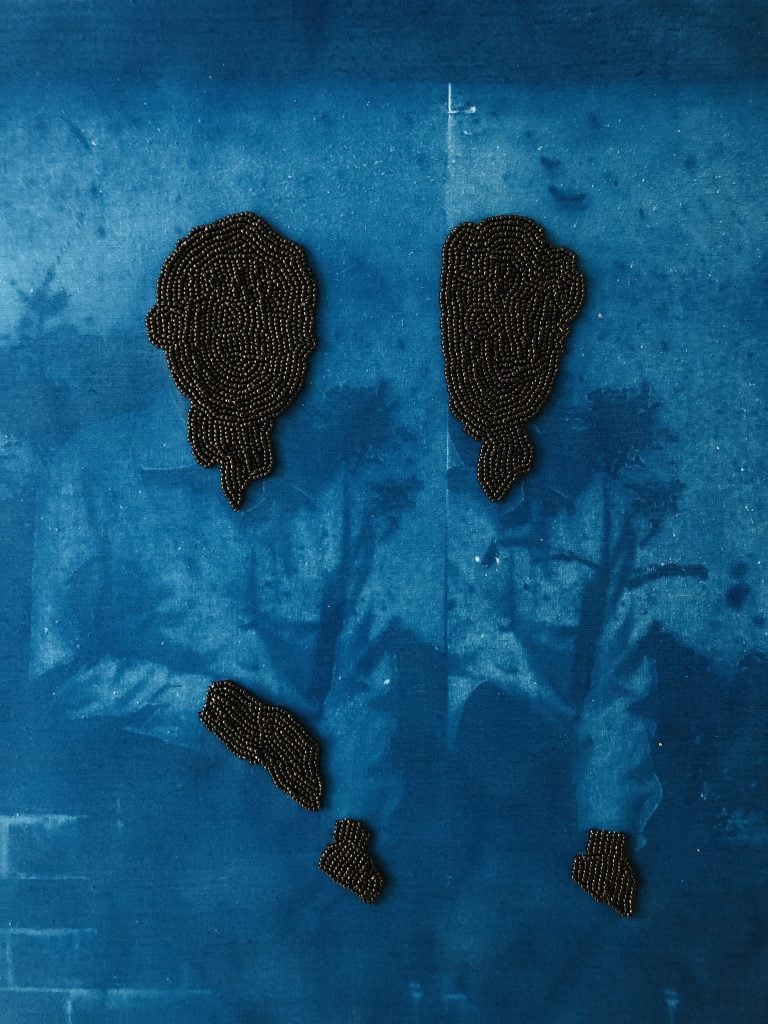
Detail. Alka Dass, Portrait of a nana sitting on the wall (2023). Courtesy Church Projects.
This small gallery on Church Street occupies a sliver of space between two buildings, but is hard to miss thanks to its gold-painted façade. Its area of focus is on emerging artists and artists from previously dispossessed communities.
In “The Million Petaled Flower Of When You Were Here,” Desi South African artist Alka Dass delicately approaches the overlooked history of Indians in South Africa, a community to which she belongs and which is rarely spoken about in South Africa. Based in Durban, one of the largest ethnically Indian-populated cities outside of India, Dass’s work engages with her history and culture, drawing imagery and gnomic texts from Hindu mythology and rituals, as well as the gender roles and expectations placed on Desi women through her use of traditionally “feminine” or outdated pastimes such as flower pressing, embroidery and beading.
A talented fiber artist, Dass’s enigmatic cyanotype prints are embellished with intricate craft methodologies like embroidery and beadwork. Borrowing archival family portraits and vintage photographs, the works evoke a nostalgic charm, but beneath the romantic veneer these inky portraits are meticulously layered with symbolism and narrative intricacies.
RESERVOIR
“Anna van der Ploeg: Shorter this time”
Through March 29, 2024
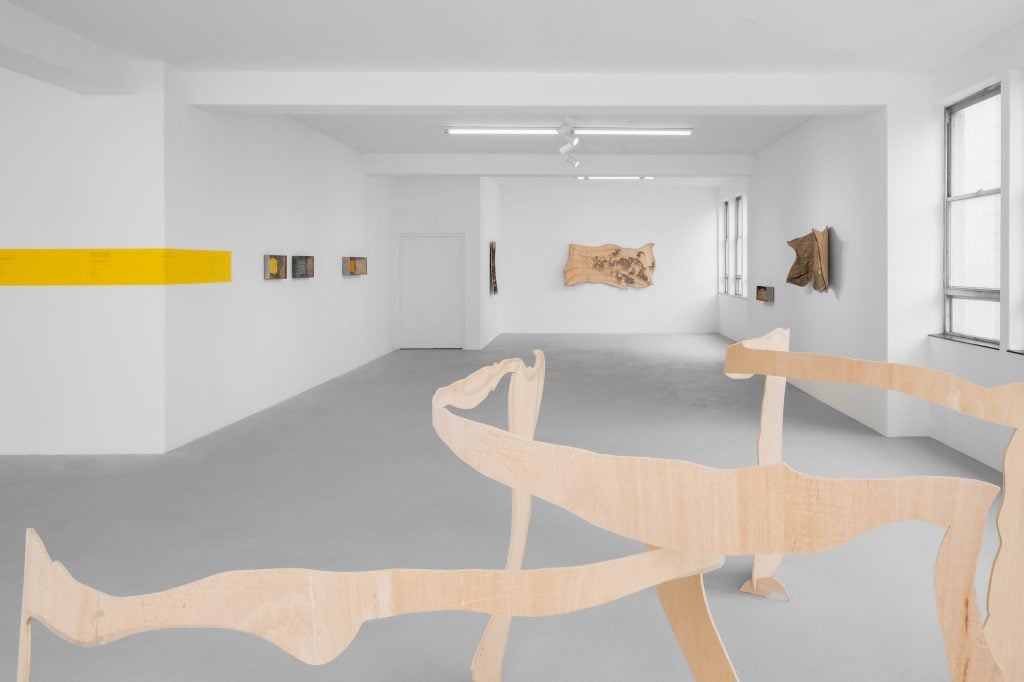
Installation view, Anna van der Ploeg, “Shorter this time.” Courtesy the artist and Reservoir.
Heinrich Groenewald and Shona van der Merwe, the curatorial duo behind the subversive art installed at the Mount Nelson, are also behind Reservoir Projects, where they are exhibiting work by painter, sculptor, and printmaker Anna van der Ploeg.
For “Shorter this time,” the Belgium-based South African artist made works while in residence at Castle House studios, conveniently located in the same complex as the gallery. The results are lyrical compositions crafted from plywood and ink, with poetic titles drawn from the works of authors such as Anne Carson and Stephen Dunn. While the subject matter may initially appear elusive, the works are subtle and emotive, and their expressive, dancing movements invite viewers to spend time unfolding their depths.
WHATIFTHEWORLD
“Maja Marx: Thinking in Tongues”
on view Investec Cape Town Art Fair, 2024
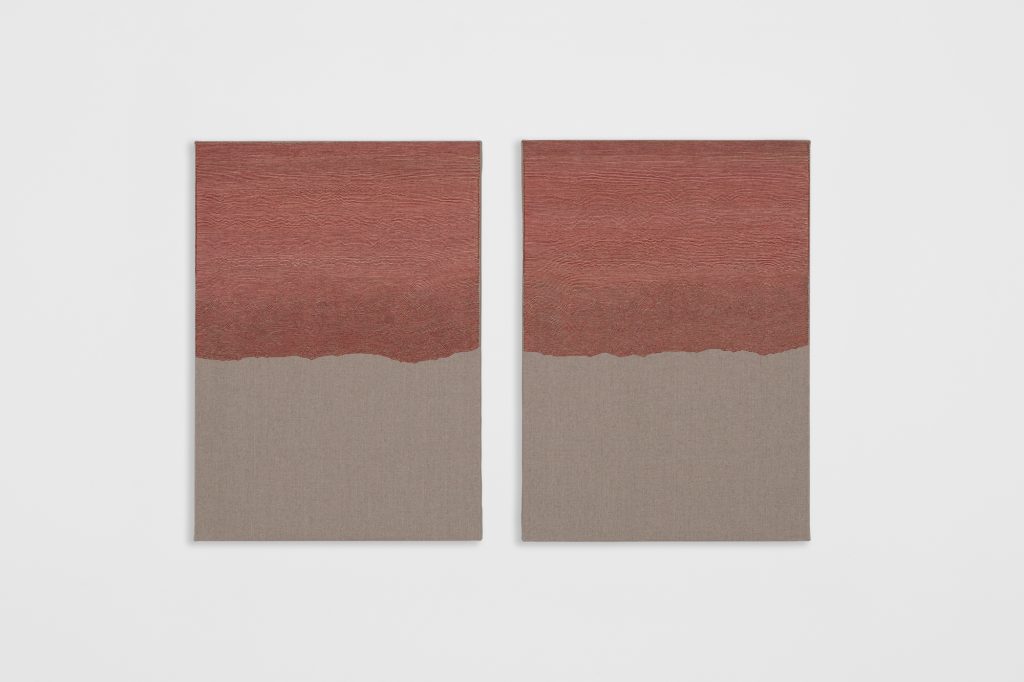
Maja Marx, The voice stands beside itself (2024). Courtesy WHATIFTHEWORLD.
The Investec Cape Town Art Fair, which took place from February 16 to 18, was tangible evidence that the international demand for African art has remained strong, even amid a global downturn. Spotted roaming the aisles alongside South African artists Zanele Muholi, Billie Zangewa, and Boemo Diale, was Art Basel’s fair director Vincenzo de Bellis as well as its global head of VIP relations Irene Kim.
Among the solo presentations at the fair, contemporary abstractions by South African artist Maja Marx were drawing attention. Titled “Thinking in Tongues” and on view with Cape Town Gallery WHATIFTHEWORLD, the presentation included a collection of paintings Marx produced by pouring a small amount of paint onto her palette each day, setting about painting lines across the canvas that record a register of her thoughts. She continued until the paint ran out, marking any major interruption by beginning again. The following day she would mix a new batch of paint and pick up wherever she left off. The artist said the resulting works was about “acknowledging syncope, or interruption of things, like ending in mid-sentence.”
“There’s no hesitation to the process, it’s not about completing,” she added. The resulting paintings could be regarded as an abstract measurement of time. The gallery sold several of these works during the fair, priced between €3,000 and €8,000 ($3,256–$8,683).
Despite the bustling global foot traffic, Mandla Sibeko, collector and owner of Art Joburg, who was attending the fair, noted that for Africa’s art market to truly thrive there needs to be an emphasis on growing the domestic market. Sibeko was frank about the matter: “Some people I was engaging with at the beginning of this journey are no longer interested in Africa, they have moved on to South America,” he said. “The success of African artists will depend on the locals opening up their eyes.”
The Norval Foundation
“Cinga Samson: Ukhe Nje Wasondela, Ndakuphosa Kulo Mlambo” (through September 1, 2024)
“Alexis Preller: Mythical Lexicon” (through November 25, 2024)
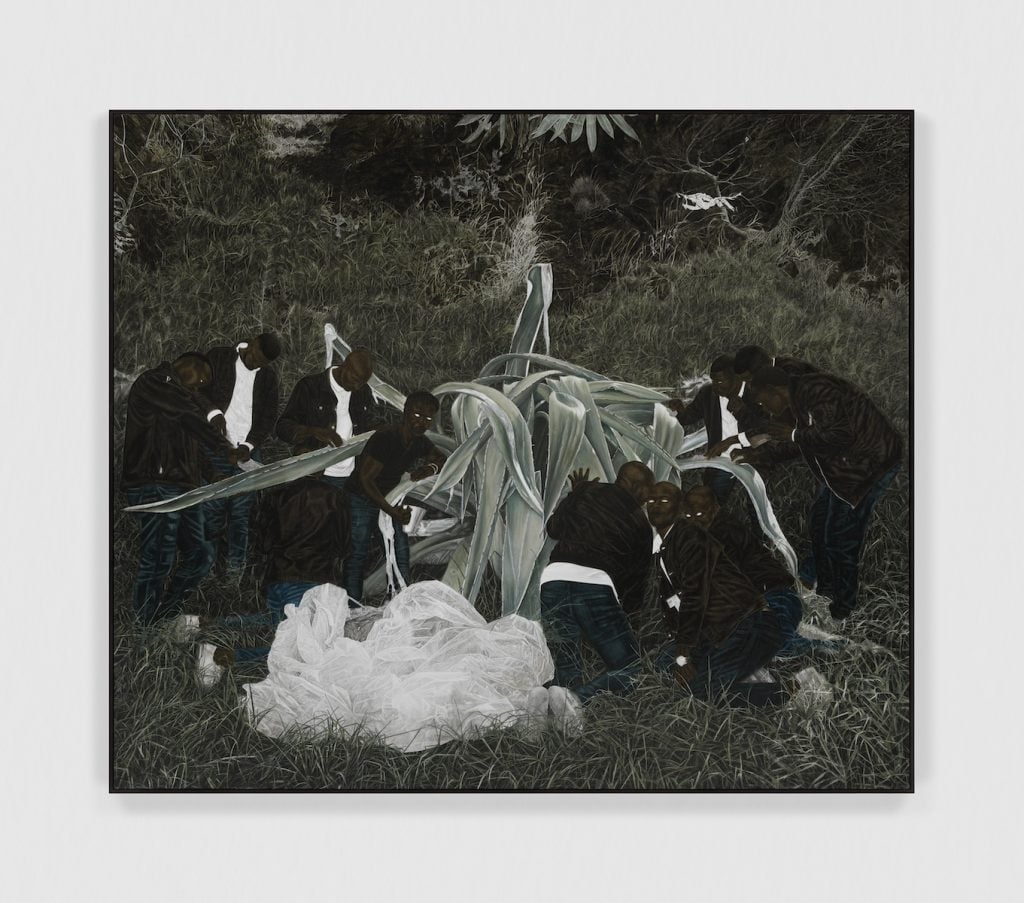
Cinga Samson, Ukuphicothwa kwento xa ingaziwa (2023). Courtesy Norval Foundation.
As the sun beat down on one of the oldest wine valleys in Cape Town, a monumental fibreglass sculpture of colorful printed fabric moved gently in the wind—recognizably a work by Yinka Shonibare, who uses colorful Dutch wax fabrics as a recurring motif in his practice to evoke the complex colonial relationships between Africa and Europe. Shonibare’s piece is one of some 20 sculptures in the garden of the Norval Foundation, which was opened six years ago by collector Louis Norval. It is distinct from some of the city’s other museums in that it houses both historic modern and contemporary African art.
On view inside the institution are two very different exhibitions that both touch on the traditions of metaphysical painting. The first is a collection of Stygian works by the rising star painter Cinga Samson. “Ukhe Nje Wasondela, Ndakuphosa Kulo Mlambo” is the ominous show title which, translated from Samson’s native isiXhosa, means “If you come close, I will throw you into the river.”
Samson thrusts the viewer as a spectator into enigmatic scenes, which explore personal and religious themes within African communities in South Africa. In one large-scale canvas, blank-eyed figures in identical sets of jeans and white sneakers gather over shrouded buckets of entrails, looking over their shoulders towards the viewer, who has seemingly intruded on this macabre ritual. In another, these same eyeless figures gather in ceremony around a giant sisal plant, stroking and butchering it in another funereal scene.
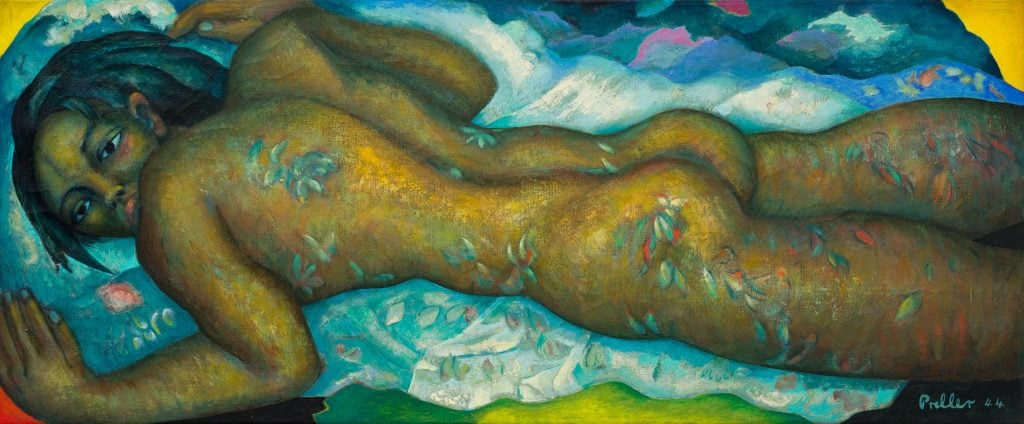
Alexis Preller, Fleurs du Mal (1944). Courtesy Norval Foundation.
The hallucinatory quality of Samson’s paintings extends across the hall to another gallery, which has been given over to an exhibition of the overlooked South African modernist, Alexis Preller.
These galleries are filled with some remarkable paintings that trace the development of his career. At first glance, one reclining nude clearly evokes Gauguin’s Tahitian paintings. But Preller’s Fleurs du Mal depicts a male figure. It’s interesting for a number of reasons, one of which being that Preller was openly gay as early as the 1940s; another is that that the study emerged from drawings of injured soldiers he encountered during his time as a prisoner of war during World War II. Both of these facts are coded in the work by the positioning of the reclining figure on his front, and by the painterly execution of the wounds as ethereal blue petals. It serves as an interesting entry point to Preller’s oeuvre: Influenced by Italian metaphysical painters like de Chirico, Preller developed a detailed visual lexicon throughout his career, and the exhibition is full of codes to decipher.






